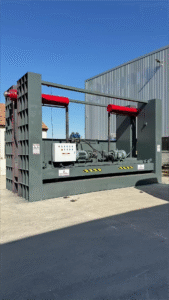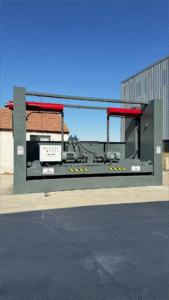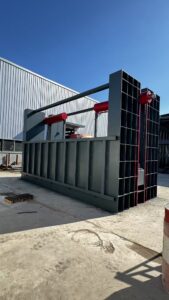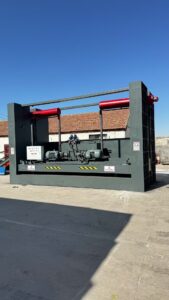As the global automotive market grows, so does the number of end-of-life vehicles (ELVs) flooding scrap yards and recycling facilities. Efficient handling of these vehicles is crucial not only for saving space and reducing transportation costs but also for supporting environmental sustainability. One of the most powerful tools in this process is the car flattening machine, also known as a car baler or car compactor.
In this article, we’ll explore everything you need to know about car flattening machines — how they work, why they matter, and what to consider when choosing the right one for your recycling operation.
What Is a Car Flattening Machine?




A car flattening machine is a type of heavy-duty hydraulic equipment used to compress end-of-life vehicles into compact, flattened forms. By reducing the size of scrap cars, these machines make storage, handling, and transportation significantly easier and more cost-effective.
Unlike car shredders that tear a vehicle apart, car flatteners simply press the vehicle into a manageable shape without separating materials. This process preserves most components and is ideal for preparatory recycling steps or export.
Key Applications
Car flattening machines are widely used in:
-
Automotive recycling plants
-
Scrap yards
-
Metal recycling facilities
-
Export preparation warehouses
-
Government environmental programs
In many regions, laws require the proper processing of ELVs to recover recyclable metals, remove pollutants, and reduce landfill usage. Car balers are an essential part of that chain.
Main Features of a Modern Car Flattening Machine
While specifications vary depending on manufacturer and model, most industrial-grade car flattening machines come with the following features:
1. High-Pressure Hydraulic System
Equipped with powerful hydraulic cylinders (often dual 350mm), the press plate can exert up to 400 tons or more of pressure. This ensures that even SUVs and pickup trucks can be efficiently flattened.
2. Strong Power Output
Typical configurations include dual motors (e.g., 2×37kW) paired with variable displacement piston pumps for stable and energy-efficient performance.
3. Large Feed Box
A wide and deep feed box (e.g., 5300×2500mm) accommodates various types of vehicles without the need for cutting or disassembly beforehand.
4. User-Friendly Control Panel
Most machines come with automatic and manual operation modes. Touch-screen controls or button-based panels offer flexibility and ease of use.
5. Heavy Frame Construction
Car balers are built with thick steel frames and reinforced components to withstand constant impact and high pressure, ensuring a long service life.
How Does a Car Flattening Machine Work?
The working principle is relatively straightforward:
-
Loading: The vehicle is placed into the feed box by a crane or grabber.
-
Positioning: Once aligned, the operator initiates the compression cycle.
-
Pressing: Hydraulic cylinders push down the pressing plate, flattening the vehicle.
-
Unloading: The flattened car is removed manually or with an automatic ejector (if available).
A complete cycle typically takes 2–5 minutes depending on the machine’s capacity and automation level.
Why Choose a Car Flattening Machine?
✅ Space Saving
Flattened cars occupy up to 80% less space, allowing you to store more units before transport.
✅ Transportation Efficiency
Reduced volume means fewer trips and lower fuel costs when shipping to recycling centers or export terminals.
✅ Environmental Compliance
Many countries require scrap processing to meet environmental standards. Using a car flattener helps ensure proper ELV treatment.
✅ Labor Reduction
Fully or semi-automatic models reduce the need for manual labor and improve workplace safety.
✅ Increased Revenue
Efficient pre-processing allows you to handle more scrap in less time, increasing throughput and potential profits.
How to Choose the Right Car Baler for Your Business
Selecting the best car flattening machine depends on your specific needs. Here are some key considerations:
1. Processing Volume
How many vehicles do you process daily? If it’s a high-throughput yard, consider a large-capacity machine (e.g., ≥1000kg/h).
2. Vehicle Type
Are you mostly dealing with sedans, or do you also handle vans, trucks, or SUVs? This affects the required feed box size and pressing force.
3. Space Availability
Ensure the machine’s footprint fits your yard or warehouse. Some machines are mobile, while others are fixed installations.
4. Power Supply
Check if your facility can support high-voltage equipment like dual 37kW motors.
5. Budget and ROI
While initial investment might be high, the long-term savings in transport, labor, and efficiency often justify the cost.
Case Study: Model 400 Car Flattening Machine
Let’s look at a popular example — the Model 400 Car Flattening Machine:
| Specification | Value |
|---|---|
| Motor | Two 37kW motors |
| Hydraulic Pump | 160 double variable displacement piston pump |
| Cylinder Configuration | Double cylinder, 350mm diameter |
| Stroke | 1.8 meters (press plate fully down) |
| Feed Box Size | 5300 × 2500 mm |
| Operation Mode | Automatic |
| Machine Weight | ≥27 tons |
This model offers robust power, generous size, and automatic control — ideal for large recycling yards and export processors.
Maintenance and Safety Tips
-
Regular Inspection: Check hydraulic oil, seals, and cylinders weekly.
-
Clean Surroundings: Keep the operating area free of debris and loose materials.
-
Trained Operators: Ensure only certified staff handle the machine.
-
Spare Parts Readiness: Stock key components like seals, filters, and control buttons.
-
Emergency Stops: Always test safety features before starting operation.
Future of Vehicle Recycling
As circular economy goals become stricter worldwide, efficient processing of end-of-life vehicles is no longer optional. Governments and environmental agencies are pushing for cleaner, more automated recycling solutions. In this future, car flattening machines will play an even bigger role, possibly integrated with smart sensors, remote diagnostics, and AI-based operation.
Conclusion
Whether you run a small scrap yard or a full-scale recycling plant, investing in a car flattening machine can streamline your operations, save costs, and boost safety. By choosing a high-quality machine suited to your materials and volume, you not only improve your efficiency but also contribute to a more sustainable world.
Looking for a reliable car baler or vehicle compactor? At AULTRAL, we provide powerful, durable, and cost-effective solutions for all your metal recycling needs.
Contact us today for a tailored quote and video demo. Let’s flatten the waste and power your profit!
Would you like a shorter version for social media, or need SEO meta titles/descriptions for this article? I can also help with formatting it for your website.
